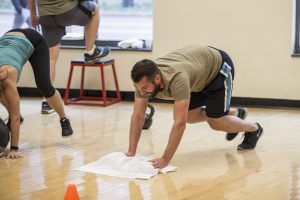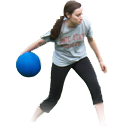
Should You Try High-Intensity Interval Training to Boost Your Brain Power?
Besides being a great, quick workout, HIIT may confer cognitive benefits. But more research is needed.
Regular exercise, research shows, can positively change the brain. Studies have found that it may help to improve brain function, boost memory, enhance mental health and possibly stave off or slow cognitive decline and protect against dementia.
Even quick bouts of exercise can have positive effects, like bolstering short-term working memory used for learning and to complete everyday tasks. And in today’s harried, fast-paced world where it seems everyone is looking for an efficiency edge, there’s increasingly interest to see if the quick-hit benefits of high-intensity interval training extend to the brain as well. HIIT is characterized by quick, intense bursts of activity alternated with short (sometimes still active) recovery periods.
One study published last year in the Journal of Cognitive Neuroscience incorporated HIIT in evaluating the potential combined effect of physical exercise plus cognitive training. In this case, an especially challenging computerized version of the memory card game. Young adult participants in the exercise group as well as those in the combined exercise plus cognitive training group did six weeks of HIIT on a stationary cycle ergometer, a bike used for fitness tests, at an individualized pace designed to get their heart rate up (to maintain a target of 90 percent of their peak heart rate) during high-intensity intervals.
HIIT was the chosen mode of exercise in the study, “because the high-intensity exercise has been shown to be most effective at increasing a growth hormone called brain-derived neurotrophic factor, or BDNF – and this is like a fertilizer for those newborn cells in the hippocampus,” says lead study author Jennifer Heisz, an assistant professor in the department of kinesiology at McMaster University in Hamilton, Ontario. This is a part of the brain that’s associated with memory; it’s thought that one way exercise helps promote the growth of these new cells involved in memory formation is through an increase in BDNF, she says.
“One of the functions of these newborn cells is that it increases the number of potential cells that can lay down a memory,” she says. That’s especially important for what’s called high-interference memory needed to be able to distinguish between an item that is new from one that you saw before that is very similar, Heisz explains. Like being able to distinguish your car in the parking lot from other cars like it. “So if you have more unique neurons to create more unique patterns, or memory representations, then your memory can be of higher fidelity,” she says. “It creates the greater potential for unique patterns, which makes it so that you are better able to distinguish that one face from someone who looks really similar” – as in the memory card task participants did in the study. “Two identical copies of images of six different faces were hidden beneath the cards,” the researchers noted. “All faces were the same size, grayscaled, and without hair,” so as to make it more difficult to distinguish between the faces and create a high-interference memory task.
The researchers found that both participants in the exercise and the combined training groups saw improvement in the high-interference memory task, whereas participants in the control group – who did no training of any kind – did not. What’s more, those individuals who experienced greater improvements in their fitness – or so-called high responders to exercise – had greater increases in neurotrophic factors BDNF and what’s called insulin-like growth factor-1. So while the effects of exercise versus combined exercise and cognitive training were similar overall, the researchers noted that “high responders to exercise also had better high-interference memory performance as a result of the combined exercise and cognitive training compared with exercise alone, suggesting that potential synergistic effects might depend on the availability of neurotrophic factors.”
In short, experts say, exercise can start a cascade of positive brain activity that may improve function in the short-term and – particularly if an exercise routine is maintained – the long run. And to some degree it appears intensity – at least challenging oneself, like getting the heart rate up – can bolster those effects. However, more study is needed to determine how HIIT compares with other forms of physical activity to boost brain power – and if it specifically provides an advantage in this regard, in addition to being a more time-efficient, albeit strenuous, form of exercise.
“I think there’s increasing data that shorter high-intensity bouts of exercise may achieve the same or better results than moderate intensity exercise,” says Dr. Clinton B. Wright, director of the division of clinical research at the National Institute of Neurological Disorders and Stroke. (Moderate intensity exercise could include brisk walking, for example, though it varies somewhat by the individual.) However, experts are quick to point out that factors such as age, current health status and whether a person is just looking for a mental edge or trying to slow cognitive decline matter in terms of whether HIIT would potentially be a good fit, and what impact it may have.
Additional research needs to be done, including randomized clinical trials, Wright says, to provide a more definitive answer about the benefits HIIT might have on cognition. “I think that we need more data about whether it has a positive effect on brain function,” he says. “Then you also have to ask, are you talking about effects on cognition in all-comers, or are you talking about effects among people that are at high risk of cardiovascular disease or are you talking about people that are already suffering from the beginnings of Alzheimer’s disease?” he says. “The devil’s in the details. It’s not a one-size-fits-all.”
Experts agree that it’s key that any exercise program match an individual’s fitness levels – so that it’s challenging within reason, and accounts for any physical limitations. Those who aren’t sure should check with a doctor first before starting a new regimen like HIIT.
“To those who can tolerate this form of exercise – and it is safe for them – we believe that it has cognitive benefits,” says Darla Castelli, a professor of kinesiology at the University of Texas at Austin. Research she was involved in published in the journal Neuroscience Letters in 2016 found that participants who did HIIT on a treadmill did better on a cognitive performance test and had increased BDNF. “BDNF actually facilitates working memory. So it allows you to hold more information in the working memory for a little bit longer period of time,” she says. That allows the brain to then more efficiently determine whether to store that information or dismiss it, she explains, if it’s not going to be needed later.
Castelli says the findings from the study she co-authored warrant further investigation about the effects of HIIT on cognitive performance, and particularly how HIIT may influence young adults, and how there might be differences with older adults.
Experts also tend to agree it would be premature to recommend HIIT over other forms of exercise to improve cognitive function or bolster brain health without more research being done first. Just as there are studies ongoing into how other forms of exercise, like moderate strength training and aerobic exercise, may affect brain function and health.
“We should be open-minded as to how we can best promote brain health – and perhaps not just one type [of exercise] is the best way,” says Teresa Liu-Ambrose, a professor in the department of physical therapy at the University of British Columbia in Vancouver and a federally appointed Canada Research Chair in Physical Activity, Mobility, and Cognitive Neuroscience.
She says that HIIT is definitely a mode of exercise researchers are very interested in. “But I think the reason we’re interested in it is because the evidence for it isn’t quite well-established,” Liu-Ambrose says. “So I think there’s potential, but we just don’t know enough to really say that it would be much better than what we know in terms of moderate intensity aerobic exercise or of moderate intensity resistance training,” she says – or for that matter, other forms of physical activity. “There’s a lot more studies now looking at dance even or yoga, because … at the end of the day there’s just multiple paths to how you can promote brain health.”
Article by Michael O. Schroeder
The Arena District Athletic Club is more than just a gym, it’s a premier fitness facility located in the heart of the Arena District in downtown Columbus. We provide convenience and quality, featuring top-of-the-line equipment, top-notch personal trainers, spa-like locker rooms and a wide variety of free group fitness classes daily including Cardio, Spinning, Barre Fusion, Yoga, Boot Camp and more. We offer free 2-hour parking and convenient contract-free memberships, to fit your healthy lifestyle needs. Don’t just join, belong.





